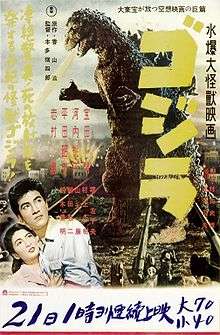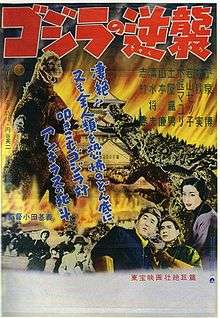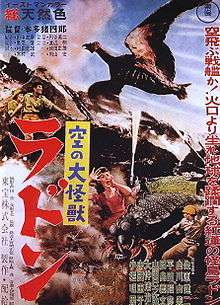Kaiju


Kaijū (怪獣 kaijū) (from Japanese "strange beast")[1] is a Japanese film genre that features monsters, usually attacking a major cities and engaging the military and other monsters in battle. It is a subgenre of tokusatsu (special effects-based) entertainment.
Related terms include kaijū eiga (怪獣映画 kaijū eiga, monster movie), a film featuring giant monsters or a single monster; kaijin (怪人, referring to roughly humanoid monsters); and daikaiju (大怪獣 daikaijū, giant kaiju), specifically meaning the larger variety of monsters.
Godzilla is an example of a daikaiju; others include Mothra, King Ghidorah, Mechagodzilla, Rodan, Gamera, Gyaos, Daimajin and Gappa. The term ultra-kaiju is longhand for kaiju in the Ultra Series.
Toho has produced a variety of kaiju films over the years (many of which featured Godzilla and Mothra) but other Japanese studios contributed to expanding the genre in Japan by producing films and shows of their own, including Daiei Film Co., Ltd., Kadokawa Pictures, Tsuburaya Productions, Shochiku and Nikkatsu studios.
Concept
Kaiju are typically modeled after conventional animals, insects or mythological creatures; however, there are more exotic examples. Chōjin Sentai Jetman features monsters based on traffic lights, faucets and tomatoes;[2] Kamen Rider Super-1 includes a whole army of monsters based on household objects such as umbrellas and utility ladders.[3]
Monsters famous in English stories, such as vampires, werewolves, mummies and zombies, fall into this category. Frankenstein's monster was a starring kaiju in the Toho films Frankenstein Conquers the World, and The War of the Gargantuas.
Kaiju are sometimes depicted as cannon fodder serving a greater evil. Some kaiju are elite warriors which serve as the right-hand man to the greater villain and are destroyed by the heroic forces. Others have a neutral alignment, only seeking to destroy buildings and other structures. During the early eras of tokusatsu, "heroic" monsters were rarely seen in daikaiju eiga films, and it was not until later when television tokusatsu productions began using kaiju which aided the hero, saved civilians, or demonstrated some kind of complex personality. These kaiju adopted many classic monster traits, appearing as the "Misunderstood Creature". Some kaiju hung out with the heroes and provided comedy relief, in contrast to the darker approach to these characters from more mature franchises, like Kamen Rider. Godzilla, arguably the most well known of the daikaiju, has played the roles of hero, villain, and force of nature in the course of his existence, one of the few kaiju of any type to be depicted in multiple roles and having those around him react in different ways, depending on how the creature itself was being presented in the films.
Selected Media
Films



Japanese
- Godzilla (1954)
- Godzilla Raids Again (1955)
- Rodan (1956)
- The Mysterians (1957)
- Varan the Unbelievable (1958)
- The Birth of Japan (1959)
- Mothra (1961)
- Gorath (1962)
- King Kong vs. Godzilla (1962)
- Atragon (1963)
- Dogora (1964)
- Frankenstein Conquers the World (1965)
- Gamera (1965)
- The Magic Serpent (1966)
- Daimajin (1966)
- The War of the Gargantuas (1966)
- The X from Outer Space (1967)
- Gappa: The Triphibian Monster (1967)
- King Kong Escapes (1967)
- Destroy All Monsters (1968)
- Latitude Zero (1969)
- Space Amoeba (1970)
- Daigoro vs. Goliath (1972)
- Legend of Dinosaurs & Monster Birds (1977)
- The Return of Godzilla (1984)
- Yamata no Orochi no Gyakushū (1985)
- Gamera: Guardian of the Universe (1995)
- Gamera 2: Attack of Legion (1996)
- Rebirth of Mothra (1996)
- Rebirth of Mothra II (1997)
- Rebirth of Mothra III (1998)
- Gamera 3: The Revenge of Iris (1999)
- Godzilla, Mothra and King Ghidorah: Giant Monsters All-Out Attack (2001)
- Ultraman: The Next (2004)
- Godzilla: Final Wars (2004)
- Negadon: The Monster from Mars (2005)
- Gamera: The Brave (2006)
- Deep Sea Monster Reigo (2008)
- The Monster X Strikes Back/Attack the G8 Summit (2008)
- Deep Sea Monster Raiga (2009)
- Gehara: The Dark and Long-Haired Monster (2009)
- Mega Monster Battle: Ultra Galaxy (2009)
- Death Kappa (2010)
- Earth Defense Widow (2014)
- Zella: Monster Martial Law (2014)
- Shin Godzilla (2016)
- Godzilla (2017)
American
- The Beast from 20,000 Fathoms (1953)
- It Came from Beneath the Sea (1955)
- The Phantom from 10,000 Leagues (1955)
- The Giant Claw (1957)
- 20 Million Miles to Earth (1957)
- The Giant Behemoth (1959)
- Q (1981)
- Zarkorr! The Invader (1996)
- Godzilla (1998)
- Kraa! the Sea Monster (1998)
- Cloverfield (2008)
- Pacific Rim (2013)
- Godzilla (2014)
- Kong: Skull Island (2017)
- Pacific Rim 2 (2018)
- Godzilla 2 (2019)
- Godzilla vs. King Kong (2020)
British
- Gorgo (1961)
Korean
Thailand
- Garuda (2004)
Danish
- Reptilicus (1961)
Comics
Japanese Manga Comic
- Cloverfield/Kishin – Manga Published By Kadokawa (2008)
- Hakaiju (2010 – 2014)
America Comic
- Gamera: Guardian of the Universe – Comic Published By Dark Horse Comics (1996)
- Giant Monster - RedSkullFace Dead – Comic Published By Boom! Studios (2005)
- Enormous (2012, 2014 – present)
- Pacific Rim: Tales from Year Zero (Warner Bros. 2013-2018/Legendary Pictures 2013)[4]
- Godzilla: Rulers of Earth[5] – Godzilla Comics Series (IDW; 2013, 1 - 25)
- Pacific Rim: Tales from the Drift (Warner Bros. 2013-2018/Legendary Pictures 2015)[6]
- Project Nemesis – Comic Published By American Gothic Press (2015)
- Kodoja – Comic Published By 215 Ink (2015, 2016) King of Zombies
- King of Zombies – Comic Published By Antarctic Press (2017 or 2018) Upcoming Soon.
- Pacific Rim: Maelstrom the Comic (Universal Pictures 2019/Legendary Pictures 2019)
Video games
- Godzilla video games (Toho; 1983 – present)
- Rampage (Bally Midway; 1986)
- Rampage 2017 (Warner Bros. Games; 2017 From Switch (NX), Wii U, PS5)
- King of the Monsters (SNK; 1991)
- Ultraman video games (Tsuburaya; 1991 – present)
- Gamera 2000 (Virgin Interactive; 1996)
- Nintendo Kaiju (Nintendo; 2017 from Switch)
- Robot Alchemic Drive (Sandlot; 2002)
- War of the Monsters (Sony, Incognito Entertainment; 2003)
- Pacific Rim video game (Yuke's/Reliance; 2013)
Television
- Marine Kong (Nisan Productions; April 3, 1960 – September 25, 1960)
- Ultra Q (Tsuburaya Productions; January 2, 1966 – July 3, 1966)
- Ambassador Magma (P Productions; July 4, 1966 – September 25, 1967)
- Ultraman (Tsuburaya Productions; July 17, 1966 – April 9, 1967)
- Kaiju Booska (Tsuburaya Productions; November 9, 1966 – September 27, 1967)
- Ultra Seven (Tsuburaya Productions; October 1, 1967 – September 8, 1968)
- Giant Robo (Toei Company; October 11, 1967 – April 1, 1968)
- Mighty Jack (Tsuburaya Productions; April 6, 1968 – June 29, 1968)
- Spectreman (Fuji Television; January 2, 1971 – March 25, 1972)
- The Return of Ultraman (Tsuburaya Productions; April 2, 1971 – March 31, 1972)
- Mirrorman (Tsuburaya Productions; December 5, 1971 – November 26, 1972)
- Redman (Tsuburaya Productions; April 3, 1972 – September 8, 1972)
- Ultraman Ace (Tsuburaya Productions; April 7, 1972 – March 30, 1973)
- Iron King (Senkosha Productions; October 8, 1972 – April 8, 1973)
- Jumborg Ace (Tsuburaya Productions; January 17 – December 29, 1973)
- Fireman (Tsuburaya Productions; January 17, 1973 – July 31, 1973)
- Zone Fighter (Toho; April 2 – September 24, 1973)
- Ultraman Taro (Tsuburaya Productions; April 6, 1973 – April 5, 1974)
- Super Robot Red Baron (Nippon Television; July 4, 1973 – March 27, 1974)
- Ultraman Leo (Tsuburaya Productions; April 12, 1974 – March 28, 1975)
- Super Sentai (Toei Company; 1975 – present)
- Godzilla (Hanna-Barbera; 1978 – 1981)
- Ultraman 80 (Tsuburaya Productions; April 2, 1980 – March 25, 1981)
- Denkou Choujin Gridman (Tsuburaya Productions; 1993 – 1994)
- Ultraman Tiga (Tsuburaya Productions; September 7, 1996 – August 30, 1997)
- Ultraman Dyna (Tsuburaya Productions; September 6, 1997 – August 29, 1998)
- Godzilla Island (Toho; 1997 – 1998)
- Godzilla: The Series (Sony Pictures Television; 1998 – 2000)
- Ultraman Gaia (Tsuburaya Productions; September 5, 1998 – August 28, 1999)
- Ultraman Cosmos (Tsuburaya Productions; July 7, 2001 – September 28, 2002)
- Ultra Q: Dark Fantasy (Tsuburaya Productions; 2004)
- Ultraman Nexus (Tsuburaya Productions; October 2, 2004 – June 25, 2005)
- Ultraman Max (Tsuburaya Productions; July 2, 2005 – April 1, 2006)
- Bio Planet WoO (Tsuburaya Productions; 2006)
- Ultraman Mebius (Tsuburaya Productions; April 8, 2006 – March 31, 2007)
- Ultraseven X (Tsuburaya Productions; 2007)
- Ultra Galaxy Mega Monster Battle (Tsuburaya Productions; December 1, 2007 – February 23, 2008)
- Ultra Galaxy Mega Monster Battle: Never Ending Odyssey (Tsuburaya Productions; December 20, 2008 – March 14, 2009)
- Ultraman Retsuden (Tsuburaya Productions; July 6, 2011 – present)
- Ultraman Ginga (Tsuburaya Productions; July 10, 2013 – December 18, 2013)
- Ultraman X (Tsuburaya Productions; July 14, 2015 – December 22, 2015)
- Enormous (Base Comic Book is Selection as Others Companys, 20th Century Fox; Fall 2016 and Early 2017)
- Ultraman Orb (Tsuburaya Productions; July 9, 2016 – present)
- Godzilla: Kaiju Force (Toho and Polygon Animation; 2018)
- Godzilla Prime (Toho and Polygon Animation; 2018)
- Big Titan (American Selection as Others Companys 2018 or 2019)
Fan films
- Godzilla X The Kaiju Killer (2009)
- GFantis: World's Collide (2011)
- Godzilla Rises (2013)
- Godzilla: Battle Royale (2014)
- Godzilla: The Destroyer of Worlds (2014)
- GFantis: DEATHGAME (2015)
- MechaGFantis Backfires (2015)
- GFantis vs. THING (2016)
- Godzilla: Heritage (2016)
Fan series
- Godzilla and his Amazing Friends (2009 – present)
- The Adventure of Ultraman & Godzilla (2010 – 2011)
References in culture
- In the Japanese language original of Cardcaptor Sakura, Sakura's brother Toya likes to tease her by regularly calling her "kaiju", relating to her noisily coming down from her room for breakfast every morning.
- In the second season of Star Wars: The Clone Wars, there is a story arc composed of two episodes entitled "The Zillo Beast" and "The Zillo Beast Strikes Back", mostly influenced by Godzilla films, in which a huge reptilian beast is transported from its homeworld Malastare to the city-covered planet Coruscant, where it breaks loose and goes on a rampage.[7][8]
- In Return of the Jedi, the rancor was originally to be played by an actor in a suit similar to the way how kaiju films like Godzilla were made. However, the rancor was eventually portrayed by a puppet filmed in high speed.[9]
- In The Simpsons: Treehouse of Horror VI - Attack of the 50-Foot Eyesores, Homer goes to Lard Lad Donuts; unable to get a "Colossal Doughnut" as advertised, he steals Lard Lad's Donut, awakening other giant advertising statues that come to life to terrorize Springfield. When Lard Lad awakes, he makes a Godzilla roar. Guillermo del Toro directed the Treehouse of Horror XXIV couch gag which made multiple references to Godzilla and other Kaiju-based characters, including his own Pacific Rim characters.[10]
- In the 2009 film Crank: High Voltage, there is a sequence parodying Kaiju films using the same practical effects techniques used for Tokusatsu films such as miniatures and suitmation.[11]
- In the 2013 film Pacific Rim, "Kaiju" is the moniker bestowed upon giant inter-dimensional monsters that invade Earth and attempt to exterminate humanity.[12]
- Kaiju-Bird Monster was the alt-mode of Decepticon Leader Emperor Deathsaurus in the Transformers: Victory anime.
- A series of cards in the Yu-Gi-Oh! Trading Card Game called "Kaiju" are inspired, both in name and/or visually, by multiple kaiju from Godzilla-related films, including Mothra, Gamera, and direct monsters of (previous) said series - Gigan, Kumonga, Rodan, MechaGodzilla, and King Ghidorah.
See also
References
| Wikimedia Commons has media related to Kaiju. |
- ↑ Yoda, Tomiko; Harootunian, Harry (2006). Japan After Japan: Social and Cultural Life from the Recessionary 1990s to the Present. Duke University Press Books. p. 344. ISBN 9780822388609.
- ↑ "Most of the Monsters of Jetman".
- ↑ "Kamen Rider Super-1". Igadevil.com.
- ↑ "Pacific Rim: Tales from Year Zero". Legendary Comics. Retrieved 2015-04-06.
- ↑ "IDW Solicits Godzilla: Rulers of Earth #12 and Vol. 3 TPB for May 2014 « SciFi Japan". Scifijapan.com. Retrieved 2014-04-29.
- ↑ "Pacific Rim: Tales from the Drift, Black Bag, Cops for Criminals - Comics Announcements". Legendary Comics. Retrieved 2015-03-25.
- ↑ ""The Zillo Beast" Episode Guide". Retrieved October 5, 2014.
- ↑ ""The Zillo Beast Strikes Back" Episode Guide". Retrieved October 5, 2014.
- ↑ "The Cinema Behind Star Wars: Godzilla". Retrieved October 5, 2014.
- ↑ "Treehouse of Horror XXIV Couch Gag by Guillermo del Toro". Youtube. October 3, 2013.
- ↑ "Crank: High Voltage: Godzilla Fight Scene". Youtube. October 1, 2009.
- ↑ "Pacific Rim - Legendary". Retrieved October 5, 2014.